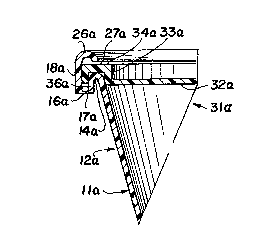Some of the information on this Web page has been provided by external sources. The Government of Canada is not responsible for the accuracy, reliability or currency of the information supplied by external sources. Users wishing to rely upon this information should consult directly with the source of the information. Content provided by external sources is not subject to official languages, privacy and accessibility requirements.
Any discrepancies in the text and image of the Claims and Abstract are due to differing posting times. Text of the Claims and Abstract are posted:
| (12) Patent Application: | (11) CA 2075437 |
|---|---|
| (54) English Title: | CONTAINER WITH CURLED TAMPER-EVIDENT BAND TO RETAIN CLOSURE |
| (54) French Title: | CONTENANT MUNI D'UNE BANDE INCURVEE INVIOLABLE SERVANT A LA FIXATION DU FERMOIR |
| Status: | Deemed Abandoned and Beyond the Period of Reinstatement - Pending Response to Notice of Disregarded Communication |
| (51) International Patent Classification (IPC): |
|
|---|---|
| (72) Inventors : |
|
| (73) Owners : |
|
| (71) Applicants : |
|
| (74) Agent: | SMART & BIGGAR LP |
| (74) Associate agent: | |
| (45) Issued: | |
| (22) Filed Date: | 1992-08-06 |
| (41) Open to Public Inspection: | 1993-02-08 |
| Availability of licence: | N/A |
| Dedicated to the Public: | N/A |
| (25) Language of filing: | English |
| Patent Cooperation Treaty (PCT): | No |
|---|
| (30) Application Priority Data: | ||||||
|---|---|---|---|---|---|---|
|
ABSTRACT OF THE DISCLOSURE
A thin-walled, wide mouth molded plastic container is
provided with a tamper evident band initially molded as a
straight-walled cylinder spaced outwardly of the lip of the
container and connected thereto by a frangible horizontal
bridge. The upper edge of the cylindrical band extends above
the level of the container lip. Subsequent to molding and
preferably before capping, the band is curled inward by
application of a curling tool. The container lid is axially
applied, the outer edge of the lid displacing the curled band
outward. The resilience of the band and bridge permits outward
deflection and immediate restoration of the curl to its initial
position. The curl prevents removal of the lid without
fracture of the bridge and removal of the tamper-evident band.
Note: Claims are shown in the official language in which they were submitted.
Note: Descriptions are shown in the official language in which they were submitted.

2024-08-01:As part of the Next Generation Patents (NGP) transition, the Canadian Patents Database (CPD) now contains a more detailed Event History, which replicates the Event Log of our new back-office solution.
Please note that "Inactive:" events refers to events no longer in use in our new back-office solution.
For a clearer understanding of the status of the application/patent presented on this page, the site Disclaimer , as well as the definitions for Patent , Event History , Maintenance Fee and Payment History should be consulted.
| Description | Date |
|---|---|
| Inactive: IPC from MCD | 2006-03-11 |
| Time Limit for Reversal Expired | 1999-08-06 |
| Application Not Reinstated by Deadline | 1999-08-06 |
| Deemed Abandoned - Failure to Respond to Maintenance Fee Notice | 1998-08-06 |
| Application Published (Open to Public Inspection) | 1993-02-08 |
| Abandonment Date | Reason | Reinstatement Date |
|---|---|---|
| 1998-08-06 |
The last payment was received on 1997-07-18
Note : If the full payment has not been received on or before the date indicated, a further fee may be required which may be one of the following
Patent fees are adjusted on the 1st of January every year. The amounts above are the current amounts if received by December 31 of the current year.
Please refer to the CIPO
Patent Fees
web page to see all current fee amounts.
| Fee Type | Anniversary Year | Due Date | Paid Date |
|---|---|---|---|
| MF (application, 5th anniv.) - standard | 05 | 1997-08-06 | 1997-07-18 |
Note: Records showing the ownership history in alphabetical order.
| Current Owners on Record |
|---|
| CAP SNAP CO. |
| Past Owners on Record |
|---|
| DANIEL LUCH |
| RAWSON CHENAULT |